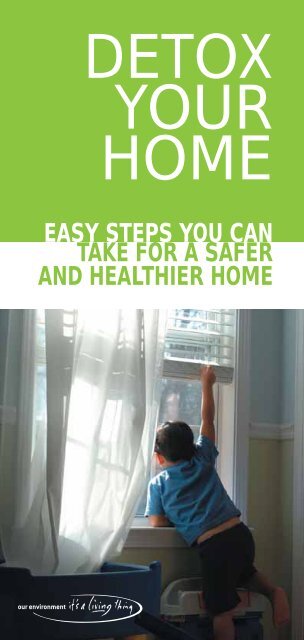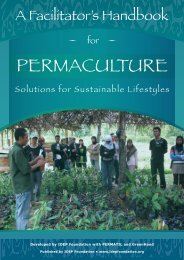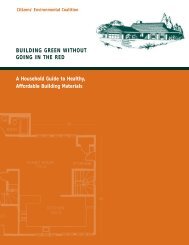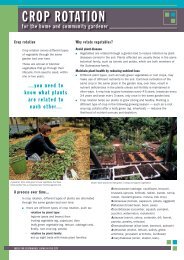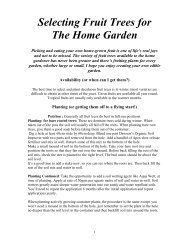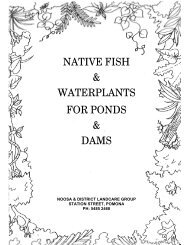DETOX YOUR HOME - Safer Solutions
DETOX YOUR HOME - Safer Solutions
DETOX YOUR HOME - Safer Solutions
You also want an ePaper? Increase the reach of your titles
YUMPU automatically turns print PDFs into web optimized ePapers that Google loves.
<strong>DETOX</strong><br />
<strong>YOUR</strong><br />
<strong>HOME</strong><br />
EASY STEPS YOU CAN<br />
TAKE FOR A SAFER<br />
AND HEALTHIER <strong>HOME</strong>
A HEALTHY <strong>HOME</strong><br />
IS A PLACE THAT IS<br />
SAFE FOR EVERYONE,<br />
ESPECIALLY CHILDREN,<br />
AND DOESN’T<br />
HURT THE LOCAL<br />
ENVIRONMENT<br />
Australians now spend<br />
more than 90% of their<br />
time indoors: at home,<br />
at school, at work and<br />
as we travel in cars and<br />
public transport. It makes<br />
sense then to make our<br />
indoor spaces as healthy<br />
and safe as we can for<br />
our families.<br />
WHAT MAKES A <strong>HOME</strong> SICK?<br />
8CEILING/ ATTIC<br />
Lead contaminated dust<br />
which can contribute<br />
to lead poisoning can<br />
accumulate in walls,<br />
ceilings and under fl oors.<br />
8LIVING ROOM<br />
Carpets, furnishings and coverings and<br />
chemical cleaning products can give off<br />
volatile organic compounds (VOCs).<br />
Many everyday items<br />
found around our homes<br />
such as household<br />
cleaners, personal care<br />
products, pesticides,<br />
carpets and furniture can<br />
emit chemicals that when<br />
combined together can<br />
reduce the quality of the air<br />
inside our home and may<br />
have impacts on our health.<br />
8SUBFLOORS<br />
Pest treatments applied<br />
under fl oors can give off<br />
fumes that may enter<br />
inside and contaminate<br />
the soil outside.<br />
Modern day illnesses,<br />
such as asthma, allergies,<br />
chemical sensitivity,<br />
hyperactivity in children<br />
and chronic fatigue<br />
syndrome are increasingly<br />
being linked to chemicals<br />
that we are exposed to in<br />
our homes. It is now widely<br />
recognized that babies<br />
and young children are at<br />
greater risk from chemical<br />
exposures, which could<br />
impact on their health and<br />
ability to learn.<br />
8BEDROOM<br />
Dry cleaned clothes,<br />
new mattresses and<br />
particleboard furniture can<br />
give off chemical fumes.<br />
SIX STEPS TO A<br />
HEALTHIER <strong>HOME</strong><br />
8GARDEN/<br />
GARAGE/ POOL<br />
Some garden chemicals<br />
and pesticides used<br />
indoors or outdoors are<br />
powerful poisons.<br />
Car batteries, pool<br />
chemicals and motor fuels<br />
contain chemicals that<br />
can burn skin or eyes.<br />
8KITCHEN<br />
Unfl ued gas appliances are<br />
major emitters of indoor air<br />
pollutants (including carbon<br />
monoxide, nitrogen dioxide, air<br />
toxics and particulates).<br />
Some drain cleaners and oven<br />
cleaners contain corrosive<br />
chemicals that can burn skin<br />
and mucous membranes.<br />
8BATHROOM<br />
Air fresheners, disinfectants,<br />
window cleaners and antimould<br />
preparations often<br />
contain chemicals such as<br />
solvents, bleach, ammonia<br />
and chlorine.<br />
Personal care products such<br />
as deodorants, perfumes,<br />
aftershave and hairspray<br />
can also contribute to the<br />
chemicals indoors.<br />
8Open windows and<br />
doors and air rooms well<br />
8Shift to natural cleaning<br />
8Replace fume emitting<br />
furnishings and coverings<br />
8Renovate with natural<br />
and low-toxic materials<br />
8Banish chemical<br />
pesticides from the home<br />
and go organic in the<br />
garden<br />
8Use natural personal<br />
care products<br />
Read on for more healthy<br />
living tips.
KEEP CHILDREN SAFE<br />
Children may be more vulnerable to chemical exposures<br />
and at greater risk than adults because their bodily<br />
systems and brains are still developing; they eat more,<br />
drink more and breathe more in proportion to their body<br />
size; and their behaviour (such as crawling or the handto-mouth<br />
activities of babies and toddlers) provides<br />
greater exposure to chemicals in and around the home.<br />
Child-safe your home<br />
Common cleaners and chemicals around the home are<br />
responsible for 95% of all childhood poisoning incidents<br />
(Kidsafe NSW).<br />
Bleach, laundry detergents, disinfectants, oven cleaners,<br />
furniture polishes, fl oor cleaners and medicines can hold<br />
a near fatal attraction to children. These often contain<br />
colourful liquids – perfect for curious toddlers.<br />
8 Try these child safe TIPS:<br />
4 Buy products which are non toxic and with childproof<br />
seals.<br />
4 Keep cleaners, solvents and other chemicals in their<br />
original container. Make sure the label is intact.<br />
4 Store in a cool, dry place out of the reach of children.<br />
4 Keep lids tightly closed to avoid leaks, spills and fumes.<br />
For more on reducing<br />
chemicals in your home,<br />
school or childcare<br />
centre, read: The Toxic<br />
Playground by Jo Immig.<br />
You can download an<br />
order form from<br />
www.safersolutions.org.au<br />
or contact Total<br />
Environment Centre<br />
on 02 9261 3437.<br />
4 Keep cockroach baits and other pesticides well away<br />
from children. Better still, don’t use them!<br />
4 Keep any potentially hazardous items such as<br />
medicines in a secured (locked) cupboard and<br />
return any unused medicines (www.returnedmed.<br />
com.au) to your Chemist.<br />
4 If you can’t use or give away leftover chemicals<br />
and cleaners make sure that you dispose of<br />
them responsibly. Contact your local council, the<br />
Environment Line on 131555 or www.cleanout.com.<br />
au for information on safe and free disposal.<br />
Keep dust down<br />
House dust often contains lead, toxic chemicals,<br />
allergens, moulds and fi bres which irritate the lungs.<br />
Reducing dust in your home through regular non-toxic<br />
cleaning and airing is one of the best ways to protect<br />
young children.<br />
8Toddlers<br />
are especially<br />
susceptible to<br />
the ill effects of<br />
household dust<br />
8Childproof locking devices<br />
are widely available<br />
<strong>HOME</strong> HEALTH<br />
AND PREGNANCY<br />
8Some chemicals can cause harm<br />
to unborn children. It is particularly<br />
important to avoid exposure to hazardous<br />
compounds during pregnancy. Solvents,<br />
pesticides (including insecticides,<br />
herbicides and fungicides), dry cleaning<br />
fl uids and anti-mould preparations are<br />
some of the chemicals that are best to<br />
avoid. Lead and other harmful chemicals<br />
can accumulate in the body and be<br />
passed to babies through pregnancy and<br />
breastfeeding and may cause low birth<br />
weight or miscarriage.
LIVING AREAS<br />
8Try these steps to healthier air inside your home<br />
Ventilate!<br />
The cheapest and easiest way to improve the air inside<br />
is to let more of the outside air in. Air circulation dilutes<br />
pollutants and helps to keep mould at bay. Ensure there<br />
is good air fl ow through windows, doors, wall vents and<br />
ducts at all times.<br />
Choose natural floorings<br />
and furnishings<br />
Avoid treated materials used in carpets, furniture covers<br />
and cushions. Where possible, choose natural and<br />
untreated materials such as wool carpets, felt underlays,<br />
hemp, cotton, linen, wool or hessian fabrics and latex or<br />
natural fi bre cushions.<br />
Floor coverings and furnishings should be aired and<br />
cleaned regularly.<br />
Freshen air naturally<br />
Instead of masking odours with artifi cial fragrances or<br />
air fresheners use your sense of smell to act on problem<br />
areas. Unpleasant odours, plastic smells and dusty smells<br />
8Low maintenance, easy to clean<br />
floorings can help prevent the build up<br />
of dust and chemicals<br />
are giving you an important message about the air<br />
quality within your home. Reduce undesirable odours by<br />
ventilating and removing the causes of the problem.<br />
Plants are nature’s air cleaners and having them inside<br />
can help to keep pollutants down. Native Kentia Palm<br />
and Dwarf Queensland Umbrella Tree along with Peace<br />
Lily and Devil’s Ivy are some of the plants suitable for<br />
indoors that can reduce indoor air pollution.<br />
8 For more on indoor air quality:<br />
4 www.safersolutions.org.au;<br />
4 Healthy Homes – A guide<br />
to indoor air quality in the<br />
home for buyers, builders<br />
and renovators<br />
(www.nphp.gov.au)<br />
8Fresh flowers and herbs<br />
are ways to naturally<br />
scent your home. Adding<br />
peppermint or rose oil to<br />
bicarbonate of soda<br />
makes a great,<br />
fragrant,<br />
low-toxic<br />
cleaner<br />
WHAT’S THAT<br />
‘PLASTIC’ SMELL?<br />
Some of the worst culprits<br />
in sick building syndrome<br />
are chemicals called<br />
Volatile Organic Compounds<br />
or VOCs. These are gases<br />
which are given off by many<br />
household items. They are<br />
invisible, but can often be<br />
smelt – the fresh plastic<br />
smell of a new car is one<br />
example.<br />
VOCs are found in some<br />
carpets and furnishings,<br />
cleaning products, polishes<br />
and waxes, paints, plastics,<br />
air fresheners, pesticides<br />
and aerosol sprays.<br />
VOCs can irritate skin, eyes,<br />
nose and throat. They can<br />
cause dizziness, nausea and<br />
headaches.<br />
Some VOCs, such as<br />
formaldehyde are known<br />
or suspected to cause<br />
cancer. Other toxic VOCs<br />
are released when, for<br />
example, household bleach<br />
mixes with ammonia-based<br />
cleaners.
KITCHENS AND BATHROOMS<br />
Switch to natural cleaning<br />
Many cleaning products contain dangerous chemicals.<br />
Disinfectants, oven cleaners, drain cleaners, fl oor<br />
polishes, anti-mould preparations and window cleaners<br />
can contain a potent mix including solvents, bleach,<br />
ammonia and chlorine.<br />
Replace chemical cleaners with natural alternatives. A<br />
cheap and environmentally friendly green cleaning kit can<br />
make your home a safe place for you and your children.<br />
<strong>YOUR</strong> GREEN<br />
CLEANING KIT<br />
8BAKING SODA<br />
A cheap environmentally<br />
friendly all purpose cleaner<br />
and stain remover. Mix a small<br />
amount to make a cleaning<br />
paste and wash off with water<br />
8VINEGAR<br />
Use white vinegar in a spray<br />
bottle to clean and cut grease.<br />
It’s a great window cleaner<br />
and glasses sparkle after a<br />
vinegar rinse. Also good for<br />
drains and septic systems<br />
8SOAP AND WATER<br />
Cleaning thoroughly with<br />
natural soap and water is<br />
effective against bacteria<br />
8OLD COTTON CLOTHING<br />
OR TOWELS make great<br />
cleaning rags and dusting<br />
cloths (using natural cloth<br />
means that they can be<br />
composted when they can no<br />
longer be used)<br />
8Try microfi bre cloths that<br />
clean with just water<br />
For more green cleaning tips:<br />
www.safersolutions.org.au<br />
and www.livingthing.net.au<br />
Practice common<br />
sense cleaning<br />
Most people just aren’t<br />
aware how harmful common<br />
household cleaners can be.<br />
Here are a few safety tips to<br />
remember:<br />
8 Don’t place them in the<br />
garbage<br />
4 Visit www.cleanout.com.au<br />
or call 131555 for your<br />
nearest Household Chemical<br />
Collection or check with your<br />
local council.<br />
8 Buy fewer cleaning products<br />
and try natural cleaning<br />
instead<br />
4 Purchase only what you<br />
need and buy concentrates<br />
or refi lls wherever possible.<br />
Many commercial cleaning<br />
products contain chemicals<br />
that can cause harm to<br />
you, your family and the<br />
environment.<br />
8 Be informed<br />
4 If you must buy commercial chemical cleaners,<br />
read the labels carefully and follow all safety<br />
instructions. If you or your family are sensitive to<br />
chemicals or suffer from asthma or allergies, take<br />
extra care. To fi nd out more about the chemical<br />
ingredients in cleaning products request a<br />
Material Safety Data Sheet from the manufacturer.<br />
Check your stoves and heaters<br />
Gas, kerosene and wood heaters and stoves produce<br />
gases and small particles that can cause breathing<br />
problems (especially for asthmatics), headaches,<br />
dizziness and nausea.<br />
Get gas appliances serviced regularly and checked for<br />
leaks. Make sure all combustion cooking and heating<br />
equipment is fl ued to the outside (ie the toxic fumes<br />
and particles are taken outside). Good ventilation will<br />
go a long way in reducing these hazards.
RENOVATING<br />
Choose bio and waterbased<br />
paints and finishes<br />
The best choice of all is plant-based bio<br />
paints, oils and fi nishes. Always choose<br />
low fume paints over oil-based paints<br />
which have high levels of VOCs which<br />
evaporate as they dry. Lighter coloured<br />
paints have less VOCs.<br />
Avoid petroleum-based paint strippers<br />
and solvents<br />
Petroleum-based paint strippers and thinners contain<br />
solvents that dissolve or thin oil-based paint. Benzene,<br />
toluene and xylene are examples of the highly hazardous<br />
solvents found in strippers.<br />
Choose less toxic alternatives such as citrus-based paint<br />
strippers and solvents. Remember water is the universal<br />
solvent if you are working with water-based products.<br />
Use natural materials<br />
Avoid using composite wood products which give off<br />
formaldehyde vapours from the glues they contain<br />
such as some chipboard, MDF (medium density<br />
fi breboard) or particle board products. Look for low VOC/<br />
formaldehyde materials where available.<br />
8It’s vital to be lead<br />
safe. Kids’ health<br />
depends on it<br />
Use natural building materials as much as possible<br />
such as recycled timber, solid sustainably-grown<br />
timber, bamboo, stone, gypsum plasterboard, cork<br />
fl ooring, natural fi bre insulation materials, underfelts<br />
and natural fl oor coverings.<br />
Be lead safe<br />
Lead exposure is a major health risk, especially to<br />
young children. Just a small amount ingested can slow<br />
children’s learning and development.<br />
Most houses built before 1970 contain lead paint.<br />
Renovating can release large amounts of leadcontaminated<br />
paint dust.<br />
8 For lead safety around the home:<br />
4 Call the Environment Line on 131555 or the Global<br />
Lead Advice and Support Service on 1800 626 086<br />
for advice and free publications such as Lead Safe: A<br />
guide to keeping your family safe from lead and Lead<br />
Safe: A renovators guide to the dangers of lead.<br />
4 Look up: www.environment.nsw.gov.au and<br />
www.lead.org.au for more lead safety tips.<br />
UNSAFE <strong>HOME</strong> RENOVATION<br />
AND MAINTENANCE ARE THE<br />
LEADING CAUSE OF ACUTE<br />
LEAD POISONING IN CHILDREN
IN THE GARDEN<br />
Use a common sense approach to pests<br />
Chemicals used to treat common pests, such as<br />
cockroaches, ants, spiders, fl eas and termites can be<br />
powerful poisons, not only for pests but also for people<br />
and pets.<br />
Often by using pesticides around the home and garden<br />
we kill the good bugs along with the bad.<br />
There is a safer way to get rid of pests around your home<br />
- apply common sense rather than toxic chemicals and<br />
aim for an integrated approach to managing unwanted<br />
house guests.<br />
Simple and environmentally friendly<br />
ways to manage pests<br />
There are three steps:<br />
8 Step 1 – Physical controls<br />
4 Make your home and garden a less attractive place<br />
for pests.<br />
4 Keep it clean! – clean up food scraps that attract<br />
insects and remove dark, moist hiding places.<br />
4 Keep them out! – block up holes and cracks,<br />
use barriers against garden pests (a ring of<br />
crushed eggshell or garden lime around seedlings<br />
discourages snails and slugs).<br />
4 Use simple traps and hand remove caterpillars and<br />
snails.<br />
8Forget about<br />
expensive artificial<br />
fertilizers. Make<br />
compost at home<br />
from food and garden<br />
wastes. It’s cheap<br />
and it works<br />
AUSTRALIANS ARE AMONG<br />
THE HIGHEST PESTICIDE<br />
USERS IN THE WORLD<br />
8 Step 2 – Biological controls<br />
4 Encourage the good insects rather than the bad<br />
– ladybirds and lacewings love to eat aphids.<br />
4 Plant fl owers and herbs such as basil, marigolds,<br />
rosemary, garlic and lavender around your<br />
vegetables. These discourage insect pests.<br />
8 Step 3 – Chemical controls – your last resort<br />
4 Try organic controls fi rst – for example, a simple<br />
homemade spray can be made from garlic.<br />
4 Use natural pyrethrum pesticides.<br />
4 If you must reach for a chemical pesticide, make<br />
sure you read and follow the label directions, only<br />
use it against the target pest, wear protective<br />
clothing and apply only as much as you need.
IN THE GARAGE<br />
In terms of sources of indoor air pollution, the garage<br />
can be a major culprit. Ensure that your garage is not<br />
contributing dangerous emissions into your home. Ideally<br />
it should be separated from the house. If connected by a<br />
door ensure the door is kept closed and the garage well<br />
ventilated to release toxic vehicle emissions.<br />
Store chemicals safely<br />
8 Store chemical items safely and take precautions when<br />
handling them<br />
4 Never store hazardous items in old food or drink<br />
containers.<br />
4 Never throw hazardous wastes down drains, the toilet,<br />
into the soil or into the garbage bin.<br />
4 Always keep chemicals in their original labeled<br />
containers.<br />
4 Always store hazardous materials in a safe, secure<br />
place well away from children and pets.<br />
NEVER PUT DANGEROUS SUBSTANCES<br />
INTO THE GARBAGE – THERE ARE<br />
SPECIAL COLLECTIONS FOR THESE<br />
Protect yourself<br />
8 If you do choose to use potentially dangerous<br />
chemicals ensure you follow all label instructions<br />
and wear protective clothing such as:<br />
4 Gloves<br />
4 Long-sleeved shirt, trousers and boots<br />
4 Safety glasses or face shield<br />
4 Appropriate mask<br />
8 And remember, prevention is always better than a cure!<br />
Practice safe disposal<br />
The garage is a common place to store hazardous<br />
materials – old paints, thinners, adhesives, car oil,<br />
solvents such as kerosene and methylated spirits,<br />
pool chlorine and old batteries. Make sure your garage<br />
doesn’t become a health hazard!<br />
Waste motor oil and<br />
batteries can be recycled.<br />
Contact your local council<br />
or www.oilrecycling.com.au<br />
to fi nd your nearest<br />
recycling depot.<br />
Unwanted chemicals<br />
can be disposed through<br />
Household Chemical<br />
Waste collections. Call<br />
131555 or your local<br />
council to fi nd out your<br />
next collection day.<br />
For information about<br />
the hazards of particular<br />
chemicals:<br />
www.safersolutions.org.au<br />
TIPS ON REDUCING<br />
LEFTOVER PAINT<br />
8Seal paint tins well after<br />
use and store upside down.<br />
This will keep the paint fresh<br />
for the next use<br />
8Buy just enough for the<br />
job at hand. 4 litres of acrylic<br />
(water based) paint will coat<br />
an area of about 60 square<br />
metres<br />
8Use leftover paint on other<br />
home improvement projects<br />
– give the dog kennel or letter<br />
box a lick of paint<br />
8Give it away to a neighbour<br />
or community group<br />
8Once all the paint is used<br />
up, let the can dry and place it<br />
out for recycling
<strong>DETOX</strong> <strong>YOUR</strong> <strong>HOME</strong><br />
Published by Total Environment Centre<br />
Level 4, 78 Liverpool Street,<br />
PO Box A176, Sydney South NSW 1235<br />
Ph: (02) 9261 3437 Fax: (02) 9261 3990<br />
Email: safersolutions@tec.org.au<br />
Website: www.safersolutions.org.au<br />
Copyright © Total Environment Centre September 2006<br />
The <strong>Safer</strong> <strong>Solutions</strong> project has been funded as part of the $3.5 million grant from<br />
the NSW Government’s Environmental Trust. This initiative brings together a range<br />
of organisations including Australian Conservation Foundation (ACF), Nature<br />
Conservation Council of NSW (NCC), Council of Social Service of NSW (NCOSS),<br />
Local Community Services Association (LCSA), Total Environment Centre (TEC), NSW<br />
Department of Environment and Conservation (DEC) and Department of Energy,<br />
Utilities and Sustainability (DEUS) to conduct a collaborative education program<br />
promoting sustainable living in NSW.<br />
ISBN 0-947360-24-7<br />
September 2006<br />
Printed on recycled paper


